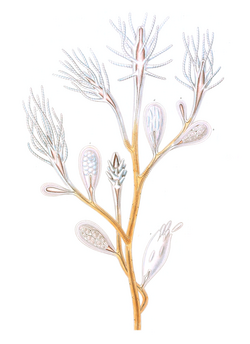Biology:Cordylophora caspia
From HandWiki
Short description: Species of hydrozoan
| Cordylophora caspia | |
|---|---|

| |
| Scientific classification | |
| Domain: | Eukaryota |
| Kingdom: | Animalia |
| Phylum: | Cnidaria |
| Class: | Hydrozoa |
| Order: | Anthoathecata |
| Family: | Cordylophoridae |
| Genus: | Cordylophora |
| Species: | C. caspia
|
| Binomial name | |
| Cordylophora caspia (Pallas, 1771) [1]
| |
| Synonyms[1] | |
| |
Cordylophora caspia (or freshwater hydroid) is a species of athecate hydroid in the family Cordylophoridae.[1]
Distribution
C. caspia is native to brackish and fresh water habitats around the Black Sea and Caspian Sea. From there it has spread, on the hulls of ships or by some other means, via channels and inland waterways to most of the temperate and tropical world.[1] It arrived in the Baltic Sea in the early nineteenth century and spread rapidly to the estuaries and inland waterways of Western Europe, reaching Ireland by 1842. By 1885 it had made its way to Australia and by 1944 to Panama. It has not reached Antarctica.[2]
References
- ↑ 1.0 1.1 1.2 1.3 van der Land, Jacob (2017). "Cordylophora caspia (Pallas, 1771)". WoRMS. World Register of Marine Species. http://www.marinespecies.org/aphia.php?p=taxdetails&id=117428.
- ↑ "Species factsheet: Cordylophora caspia". DAISIE. http://www.europe-aliens.org/speciesFactsheet.do?speciesId=50150#. Retrieved 8 August 2017.
Wikidata ☰ Q387976 entry

